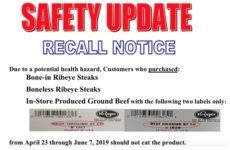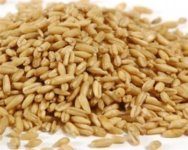Currently, pathogens on fresh-produce are reduced by washing and sanitizing the products. These processes generate harmful substances and do not reduce enough the levels of pathogens. Scientists from Seoul National University published a study in Applied and Environmental Microbiology (https://aem.asm.org/content/85/12/e00006-19) better decontaminating fresh produce by combining the Spindle apparatus, which detaches microorganisms on sample surfaces, and a 222-nm krypton-chlorine excimer lamp (KrCl excilamp) (Sp-Ex). They tested the process on Escherichia coli O157:H7, Salmonella enterica serovar Typhimurium, and Listeria monocytogenes on apple and bell pepper surfaces. This study found reduced pathogens on apple and bell pepper surfaces using sanitizer-free water without altering produce color and texture. E. coli O157:H7 and S. Typhimurium were reduced by more than 6 logs after 5 min treatment. L. monocytogenes on apple and bell pepper surfaces were reduced by 4.26 and 5.48 logs, respectively, after 7 min of treatment. It was found that the decontamination effect was significantly (P < 0.05) increased by the addition of 0.1% Tween to the wash solution.
ruth
In this study, we developed a washing system capable of decontaminating fresh produce by combining the Spindle apparatus, which detaches microorganisms on sample surfaces, and a 222-nm krypton-chlorine excimer lamp (KrCl excilamp) (Sp-Ex) and investigated their decontamination effect against Escherichia coli O157:H7, Salmonella enterica serovar Typhimurium, and Listeria monocytogenes on apple (Malus domestica Borkh.) and bell pepper (Capsicum annuum L.) surfaces. Initial levels of the three pathogens were approximately 108 CFU/sample. Both E. coli O157:H7 and S. Typhimurium were reduced to below the detection limit (2.0 log CFU/sample) after 5 and 7 min of treatment on apple and bell pepper surfaces, respectively. The amounts of L. monocytogenes on apple and bell pepper surfaces were reduced by 4.26 and 5.48 logs, respectively, after 7 min of treatment. The decontamination effect of the Sp-Ex was influenced by the hydrophobicity of the sample surface as well as the microbial cell surface, and the decontamination effect decreased as the two hydrophobicity values increased. To improve the decontamination effect of the Sp-Ex, Tween 20, a surfactant that weakens the hydrophobic interaction between the sample surface and pathogenic bacteria, was incorporated into Sp-Ex processing. It was found that its decontamination effect was significantly ( P 0.05). Our results suggest that Sp-Ex could be applied as a system to control pathogens in place of chemical sanitizer washing by the fresh-produce industry.
IMPORTANCE Although most fresh-produce processing currently controls pathogens by means of washing with sanitizers, there are still problems such as the generation of harmful substances and changes in product quality. A combination system composed of the Spindle and a 222-nm KrCl excilamp (Sp-Ex) developed in this study reduced pathogens on apple and bell pepper surfaces using sanitizer-free water without altering produce color and texture. This study demonstrates the potential of the Sp-Ex to replace conventional washing with sanitizers, and it can be used as baseline data for practical application by industry. In addition, implementation of the Sp-Ex developed in this study is expected not only to meet consumer preference for fresh, minimally processed produce but also to reduce human exposure to harmful chemicals while being beneficial to the environment.
ruth
Kroger announced the recall of ground beef and ribeye steaks sold in Indiana, Ohio, and Kentucky, due to E. coli. The recall applies to bone-in ribeye steaks, boneless ribeye steaks and ground beef sold between April 23 and June 3. Kroger said the recall includes stores in southeastern Indiana, Dayton, Greater Cincinnati, and Northern Kentucky. Kroger says there have been no confirmed reports of illness due to the consumption of the products at this time. @ https://fox59.com/2019/06/10/kroger-recalls-ground-beef-ribeye-over-e-coli-concerns/
Kroger shoppers should check their freezers after the grocery store chain recalled ground beef and ribeye steaks sold in Indiana, Ohio and Kentucky.
According to Kroger, the meat was recalled due to a risk of E. coli contamination. It applies to bone-in ribeye steaks, boneless ribeye steaks and ground beef sold between April 23 and June 3.
ruth
IEH Laboratories & Consulting Group together with The WhiteWave Foods Company and ConAgra Foods, Inc. conducted a baseline study to create a baseline of the prevalence and levels of pathogens in wheat samples taken before milling. A total of 5,176 wheat samples were tested for enterohemorrhagic Escherichia, coli (EHEC), Salmonella spp., Listeria spp., and L. monocytogenes. 3,891 samples were tested for E. coli and Salmonella, and 1,285 were tested for Listeria. Salmonella was detected in 1.23% of the samples (average count of 0.110 cfu/g), EHECs occurred in 0.44% of the samples (0.039 cfu/g), and Listeria spp. occurred in 0.08% of samples (0.020 cfu/g), but L. monocytogenes was not detected. The data shows that contamination is coming from many sources, and raw flour is likely to be contaminated with pathogens. Therefore, it is best to cook wheat products as a measure against pathogens. @ https://jfoodprotection.org/doi/abs/10.4315/0362-028X.JFP-18-345
https://jfoodprotection.org/doi/abs/10.4315/0362-028X.JFP-18-345
ruth
Dungeness Valley Creamery of Sequim, Washington recalled their raw whole milk, raw skim milk, and raw cream, due to potential contaminated with E. coli bacteria. The same products (from the same facility) were recalled in April 2019 for E. coli. No illnesses have been reported. Washington State Department of Agriculture found the toxin-producing E. coli bacteria in retail raw whole milk during routine sampling. The raw whole milk, raw skim milk, and raw cream were labeled with best by dates of 6/05 to 6/14. The dairy products were sold to customers, including retail stores, in western Washington State. It’s legal to sell and buy raw milk in Washington state, but “the potential health risks are serious,” @ https://foodpoisoningbulletin.com/2019/dungeness-valley-creamery-recalls-raw-milk-e-coli/
Dungeness Valley Creamery of Sequim, Washington, is recalling raw whole milk, skim milk, and cream for possible E. coli contamination.


